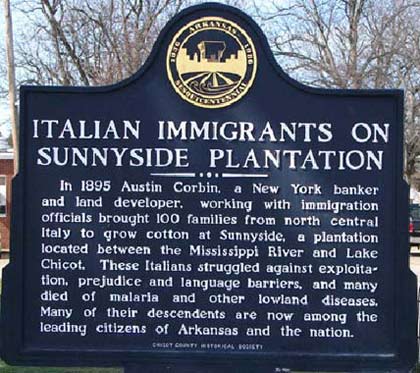
About Sunnyside Plantation, the Inspiration for my novel Sweet Hope.
At the very end of the 1800s into about the first decade of the 1900s, Italians were illegally imported to various places in the southern United States to work on cotton plantations, or in sugar cane fields, turpentine mills, cotton factories, etc. It was serendipitous that a few months after I went to the Lake Village, Arkansas/ Sunnyside area in search of the place my grandmother (and great aunt) had talked so much about, I learned that a historian, Randy Boehm had been there a few months earlier to research the “Italian Colony Experiment” on Sunnyside plantation and the Federal investigation into charges of peonage and violations of alien labor laws headed by the “lady lawyer in pants,” from New York City, Mary Grace Quackenbos.
I became friends with Randy, who shared much of his research with me and directed me to the National Archives in Washington, D.C. where I photocopied over 100 pages of documents. Randy introduced me to Ernesto Milani who was also researching Sunnyside Plantation from the Italian government’s perspective. The three of us met a few times at Randy’s place in Maryland to exchange information and attended a few conferences where two or all three of us presented papers or talks on the topic. One wonderful result of Randy and Ernesto’s work was a book of essays written by different historian-scholars focusing on the Italians at Sunnyside: Shadows Over Sunnyside: An Arkansas Plantation in Transition, 1830-1945, edited by Jeannie M. Whayne, University of Arkansas Press 1993, reissued in paperback in 1995. Both men have essays in the book (I do not).
The United States government itself initiated a Federal investigation in 1907 after numerous complaints from various people, including complaints that reached the Italian government, which placed its own pressure on the U.S. government for some answers. Investigations were conducted not only on Sunnyside (my inspiration for Sweet Hope), but also various other plantations and places of work throughout the south. Sunnyside resulted in the largest, most involved investigation. Randy’s big interest was learning about “the lady lawyer in pants” who had her own people’s law firm in NYC and saved several immigrants from 11th hour incarceration, deportation, or worse. This was at a time when women did not yet have the right to vote. Randy wrote a screenplay about her, plus a biography, and shared much of this work with me.
What makes the actual Sunnyside case more potentially explosive to me is not just that Italian agents sold out their own people (this happens often, unfortunately, with many ethnic groups, and probably did not involve a large number of Italian agents. It still happens today). More interesting to me is the fact that one of the three owners of Sunnyside at the time was LeRoy Percy, of the wealthy and influential Percy family of Greenville, Mississippi. LeRoy was related to famous writer Walker Percy, William Walker Percy, and, indirectly, to Shelby Foote, and he became Senator from Mississippi. At the time of the 1907 Federal investigation, he was friendly with U.S. President Theodore Roosevelt, having taken the president on one of his famous bear hunts. Percy first tried to charm and dismiss the “lady lawyer,” but when she persisted in carrying out a real and thorough investigation, he used various negative tactics and letter writing to the president and other politicians to discredit her as socialist instigator and a northerner who knew nothing of cotton farming or of the ways of the Delta, and who thus was stirring up trouble out of her ignorance. In the end, the investigation went forward, but Percy was acquitted while a couple of his workers had minor charges brought against them. After the charges, Percy did make a few changes to appease the Italians. The full Quackenbos report, letters from her to the Department of Justice, letters from Percy to the same department and to the president, etc., are all documented in the National Archives. Photocopies of these documents are in my possession, and a few are published in the Shadows Over Sunnyside book.
What I can find no clear documentation of, though, is the fact that a number of African American families remained living and working on Sunnyside, most likely as sharecroppers, alongside the Italians who were held under a contract labor agreement. I have tape recorded my grandmother Pasquina Fratini Galavotti telling me about the “colored” people who lived among the Italians at Sunnyside, her friendship with a “colored girl” her age, and her family’s friendship with a “colored family” they used to visit and even at times share a meal with. Her father would sometimes play cards with them. My grandmother also told me of two horrible instances of violence by whites against blacks that she witnessed on Sunnyside and that left a lasting impression. Her sister, my great Aunt Mary, also told me about the events, independent of my grandmother’s telling.
Their father had taken two or three of the four children to the company store to buy some provisions. A white “boss man” climbed up on a table inside the store full of people and called out for a man to come over to him. “He call and call for this man, a colored man, and when the man come up to the table, poong! he shoot him dead right there in the store.”
I was shocked. “Were you scared? What did you do?”
“Sure we was scared. My daddy, he hurry us out the store saying Shh, don’t say a word, don’t look back, maybe they shoot us too.”
The other incident also involved a black man, also at the company store. My grandmother’s family was going to the store again. Outside the store was a “machine” to which was strapped a naked black man. The machine had a “belt” that “went around” and every time it went around, “poong, it hit the man on his backside and boy he cry out. How many times it went around. I don’t know what he done. Sure, that belt hurt him.”
As my dedication to Sweet Hope states, the book is for “all the inhabitants of Sunnyside Plantation, Italian and African American, whose voices were never heard and whose stories were never told.”
My novel is, of course, fiction and is not meant to represent any real people or the actual events of any one real place.

Also Try:

